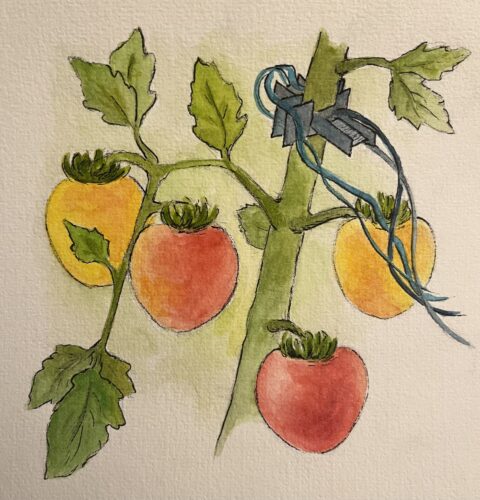Art Courtesy of Molly Hill.
Consider a scenario where you’re at a doctor’s office battling the flu. Your doctor diligently measures your blood pressure, listens to your lungs with a stethoscope, checks your reflexes, and examines your body temperature. These thorough examinations directly listen to your body and are essential for your doctor to evaluate your health condition. Now, imagine a similar approach to monitoring the health of plants using devices that directly track their health. How could this be possible?
Currently, the most common technology in smart agriculture involves sensors that track environmental conditions to determine the health of the plants grown nearby. Researcher Uberto Garlando and professor Danilo Demarchi, both affiliated with the Italian university Politecnico di Torino, and members of the Institute of Electrical and Electronics Engineers Council are taking a more advanced approach to understanding the plants’ needs. “To understand the plant status and be able to detect stresses such as pest infections, we developed devices and electronic systems that are ‘plant-wearable’ that focused on proper status detection [by] simply ‘asking’ the plant [what it needs],” Garlando said.
These sensors work by tracking electrical signals within the plant that vary when subjected to different environmental conditions like leaf temperature and water content stress. When the plants “wear” these sensors, the farmers can monitor the health of their plants based on the variance of these electrical signals. “The sensors extract a signaling frequency proportional to the electrical signals of the plants that can give us information about the plants’ health,” Demarchi said.
To monitor plants at a lower cost, these sensors extract a signaling frequency that is less accurate than previous renditions of similar sensors. Despite the trade-off between cost and accuracy, the researchers concluded that the frequency they used was still meaningful enough for the farmers to understand the needs of their plants. “The best trade-off is when you can get information out of the minimum cost possible,” Garlando said. “Our final goal is to reduce the cost to a few cents for each device.”
Empowered by information about the plants’ health from these cheaper sensors, farmers can avoid the overuse of resources necessary for growing plants. “With this technology, it’s possible to reduce, for example, the use of pesticides or chemicals in agriculture because instead of spreading the pesticide on all the crops, I know where specifically I need to use the pesticide,” Demarchi said. Reducing the use of chemicals in agriculture limits waste, protecting local ecosystems and bodies of water from chemical pollutants.
These “plant-wearable” sensors also come at a time of accelerating climate change, with the amount of arable farmland drastically decreasing. Electrical engineers like Garlando and Demarchi have been working on developing low-cost, smart agri-food systems in the past decade to benefit farmers with higher agricultural yields under harsh conditions.
Overall, Garlando and Demarchi believe that these “plant-wearable” devices will fundamentally change the agricultural industry, making it more environmentally sustainable and efficient in the hopes of increasing global food security. The sensors also pave the way for the popularization of agricultural technology (AgriTech) engineering in universities. The Politecnico di Torino University recently released a new master’s degree program in AgriTech engineering. “The engineering AgriTech culture still has to grow,” Demarchi said. By working with agricultural companies, Demarchi hopes that engineers can bring their ideas to real-world use. He also aspires to motivate more researchers to work on problems faced by the agricultural industry in Italy and beyond.
Looking at the future of the AgriTech industry, Garlando, Demarchi, and other engineers are hoping to improve their technology by further decreasing the costs of the sensors while maintaining enough accuracy to determine the needs of the plants. “Of course, we are proud of these sensors so far,” Demarchi said. “However, we are always going to continue to improve our devices and our sensors. We are working toward reducing the device size and power consumption in the future.” For now, we can only wonder whether the fruits and vegetables we have been eating have worn these “plant-wearable” sensors, developed to fight against climate change and enhance food security.

